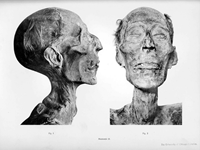The video below, a scientific visualisation of galaxies captured as part of the CEERS (Cosmic Evolution Early Release Science) Survey, reveals a major undertaking by NASA's James Webb Space Telescope. It passes by thousands of galaxies, starting with those nearby and ending with less advanced galaxies in the far-flung universe, including a galaxy never seen before Webb.
The area highlighted in this visualisation is a small part of the Extended Groth Strip, a region between the constellations of the Big Dipper and Boötes observed by the Hubble Space Telescope between 2004 and 2005. While this large region contains about 100,000 galaxies, the visualisation focuses on about 5,000 galaxies - the closest and more complex galaxies initially shown are located within a few billion light-years of Earth. As the visualisation progresses, we see different stages in the history and evolution of the universe, showing galaxies further away from Earth.
The most distant galaxy in the visualisation, known as the Maisie Galaxy, is a target of great interest to astronomers. It was formed about 390 million years after the Big Bang, about 13.4 billion years ago. It is not only one of the first bright, extremely distant galaxies found by Webb, but also an early example of a galaxy that only Webb could see. This is because Webb's instruments were able to capture light from these early galaxies, which had shifted to infrared wavelengths as the universe expanded.
"This observatory opens up this entire time period for us to study," said Rebecca Larson of the Rochester Institute of Technology in Rochester, New York, who led the research. "Before, we couldn't study galaxies like Maisie's because we couldn't see them. Now, not only can we find them in our images, but we can also learn what they're made of and whether they're different from galaxies we see near us."
Steven Finkelstein of the University of Texas at Austin, principal investigator of the CEERS programme, said: "This observation exceeded our expectations. The number of galaxies we found in the early universe is at the upper limit of all predictions." The observatory's ability to conduct such surveys provides a demonstration of Webb's instruments that astronomers can reference for future observations.
This visualisation not only shows how far away Webb was able to observe, but also how far Hubble has improved on its achievements. In many cases, Hubble's observations, together with Webb's data from the CEERS Survey, enabled researchers to determine which galaxies were indeed distant - the early universe galaxies of interest - and which were nearby but so dusty that their visible light was obscured.
With these observations, the researchers' next goal is to learn about the formation of stars in these early galaxies.
"We're used to thinking that galaxies grow in a smooth way," Finkelstein said. "But maybe these stars are forming like fireworks. Are these galaxies forming more stars than expected? Are the stars they form more massive than we expected? These data have given us the information we need to ask these questions. Now we need more data to get these answers."
Source: https://www.nasa.gov/


 Nielawore
Nielawore









Yorum yazmak için lütfen giriş yapınız